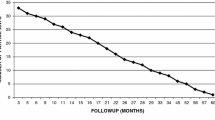Abstract
Background
The Ponseti method for treating congenital clubfoot requires Achilles tenotomy to be performed toward the end of serial casting. However, it remains unclear if Achilles tenotomy has a negative effect on clubfoot-associated calf-muscle atrophy. We therefore investigated this issue by ultrasonographic examination.
Materials and methods
We studied 36 patients with congenital clubfoot who were treated with the Ponseti method and underwent Achilles tenotomy. Only unilateral cases were evaluated to enable comparison of the severity of atrophy and its changes over time between affected and unaffected sides. Tenotomy was performed at a mean age of 10.2 weeks after birth (range 8–16 weeks). The transverse and anteroposterior diameters of the calf muscles on the unaffected and affected sides were measured ultrasonographically by two examiners. The mean observation period was 27 months (range 24–34 months). Measurements were performed within 6 months after tenotomy, between 7 and 17 months after tenotomy, and at the final assessment. Differences between the diameters of the affected and unaffected sides at each time point, and changes in the diameters over time were determined. The data were analyzed by use of one-way ANOVA and repeated-measures ANOVA.
Results
Tendon healing and gliding were achieved in all cases. There were significant differences between the diameters of the unaffected and affected sides at all measurement points (transverse p < 0.005, anteroposterior p < 0.01). The diameters of calf muscles on both sides increased significantly over time (p < 0.0001). The patterns of change in diameter were similar on both sides.
Conclusion
The transverse and anteroposterior diameters of the calf muscles differed significantly between the affected and unaffected sides after Achilles tenotomy, but there were no significant differences in changes over time. These results suggest that Achilles tenotomy had no negative short-term effects on calf-muscle atrophy associated with clubfoot.




Similar content being viewed by others
References
Herzenberg JE, Radler C, Bor N. Ponseti versus traditional methods of casting for idiopathic clubfoot. J Pediatr Orthop. 2002;22:517–21.
Ponseti IV. Congenital clubfoot: fundamentals of treatment. New York: Oxford University Press; 1996. p. 1–140.
Colburn M, Williams M. Evaluation of the treatment of idiopathic clubfoot by using the Ponseti method. J Foot Ankle Surg. 2003;42:259–67.
Scher DM, Feldman DS, van Bosse HJ, Sala DA, Lehman WB. Predicting the need for tenotomy in the Ponseti method for correction of clubfoot. J Pediatr Orthop. 2004;24:349–52.
Dobbs MB, Rudzki JR, Purcell DB, Walton T, Porter KR, Gurnett CA. Factors predictive of outcome after use of the Ponseti method for the treatment of idiopathic clubfeet. JBJS-Am. 2004;86:22–7.
Morcuende JA, Abbasi D, Dolan LA, Ponseti IV. Results of an accelerated Ponseti protocol for clubfoot. J Pediatr Orthop. 2005;25:623–6.
Bor N, Herzenberg JE, Frick AL. Ponseti management of clubfoot in older infants. Clin Orthop Rel Res. 2006;444:224–8.
Bor N, Coplan JA, Herzenberg JE. Ponseti treatment for idiopathic clubfoot. Minimum 5-year followup. Clin Orthop Relat Res. 2009;467:1263–70.
Niki H, Nakajima H, Hirano T, Okada H, Beppu M. Ultrasonographic observation of the healing process in the gap after a Ponseti-type Achilles tenotomy for idiopathic congenital clubfoot at two-year follow-up. J Orthop Sci. 2013;18(1):70–5.
Caiozzo VJ, Utkan A, Chou R, Khalafi A, Chandra H, Baker M, Rourke B, Adams G, Bladwin K, Green S. Effects of distraction on muscle length: mechanisms involved in sarcomerogenesis. Clin Orthop Relat Res. 2002;403(Suppl):S133–45.
Goldspink G, Williams P, Simpson H. Gene expression in response to muscle stretch. Clin Orthop Relat Res. 2002;403(Suppl):S146–52.
Caiozzo VJ, Green S. Breakout session 3: issues related to muscle growth atrophy, and tissue engineering. Clin Orthop Relat Res. 2002;403(Suppl):S252–61.
Bechtol CO, Mossman HW. Clubfoot; an embryological study of associated muscles abnormalities. J Bone Joint Surg Am. 1950;32:827–38.
Flinchum D. Pathological anatomy in talipes equinovarus. J Bone Joint Surg Am. 1953;35:111–4.
Wiley AM. Club foot: an anatomical and experimental study of muscle growth. J Bone Joint Surg Br. 1959;41:821–35.
Irani RN, Sherman MS. The pathological anatomy of clubfoot. J Bone Joint Surg Am. 1963;45:45–52.
Shlicht D. The pathological anatomy of talipes equinovarus. Aust N Z J Surg. 1963;33:1–11.
Waisbrod H. Congenital club foot. An anatomical study. J Bone Joint Surg Br. 1973;55:796–801.
Ippolito E, Ponseti IV. Congenital club foot in the human fetus. A histological study. J Bone Joint Surg Am. 1980;62:8–12.
Aronson J, Puskarich CL. Deformity and disability from treated clubfoot. J Pediatr Orthop. 1990;10:109–19.
Ippolito E, De Maio F, Mancini F, Bellini D, Orefice A. Leg muscle atrophy in idiopathic congenital clubfoot: is it primitive or acquired? J Child Orthop. 2009;3:171–8.
Saini R, Dhillon MS, Tripathy SK, Goyal T, Sudesh P, Gill SS, Gulati A. Regeneration of the Achilles tendon after percutaneous tenotomy in infants: a clinical and MRI study. J Pediatr Orthop [B]. 2010;19(4):344–7.
Conflict of interest
No benefits in any form have been received or will be received from a commercial party related directly or indirectly to the subject of this article.
Author information
Authors and Affiliations
Corresponding author
About this article
Cite this article
Niki, H., Nakajima, H., Hirano, T. et al. Effect of Achilles tenotomy on congenital clubfoot-associated calf-muscle atrophy: an ultrasonographic study. J Orthop Sci 18, 552–556 (2013). https://doi.org/10.1007/s00776-013-0398-x
Received:
Accepted:
Published:
Issue Date:
DOI: https://doi.org/10.1007/s00776-013-0398-x




